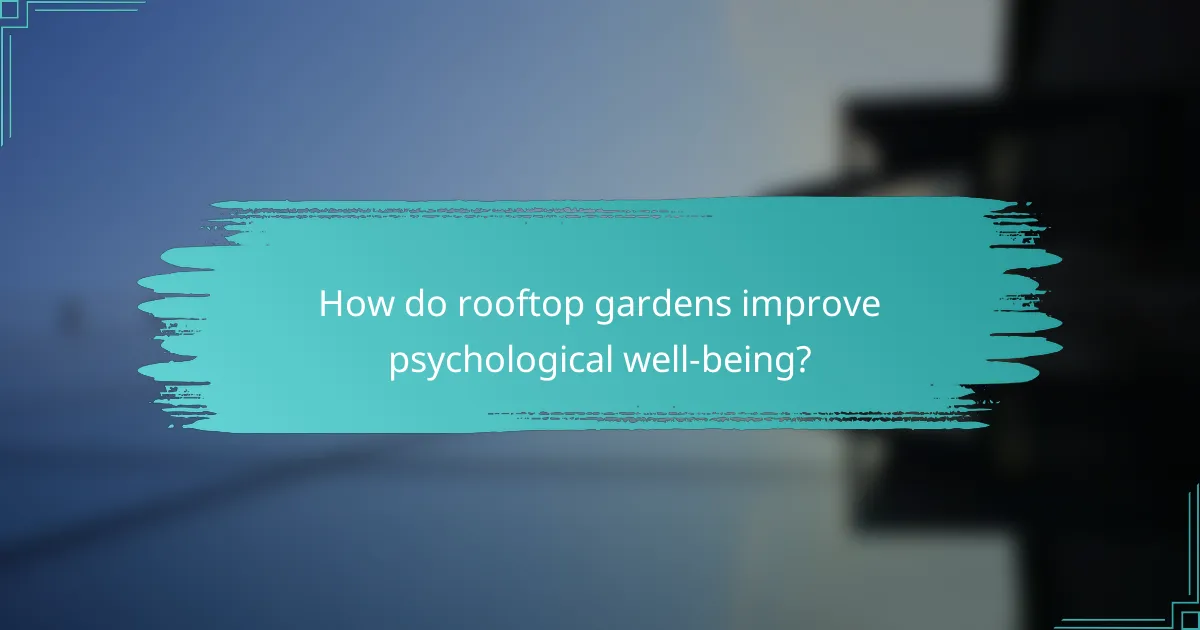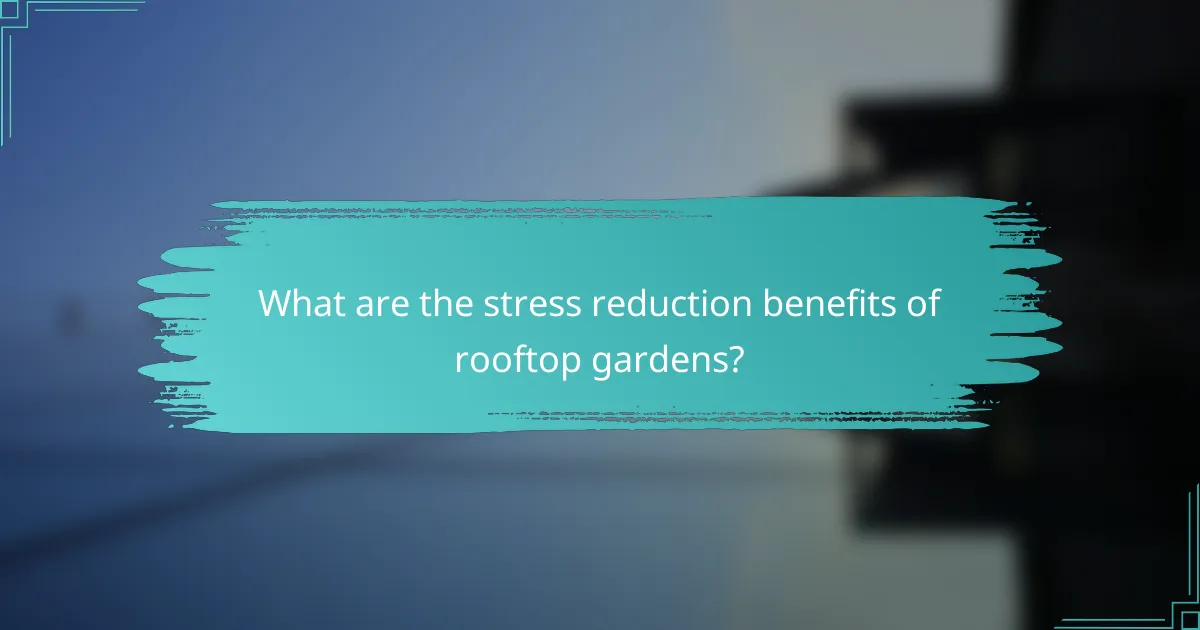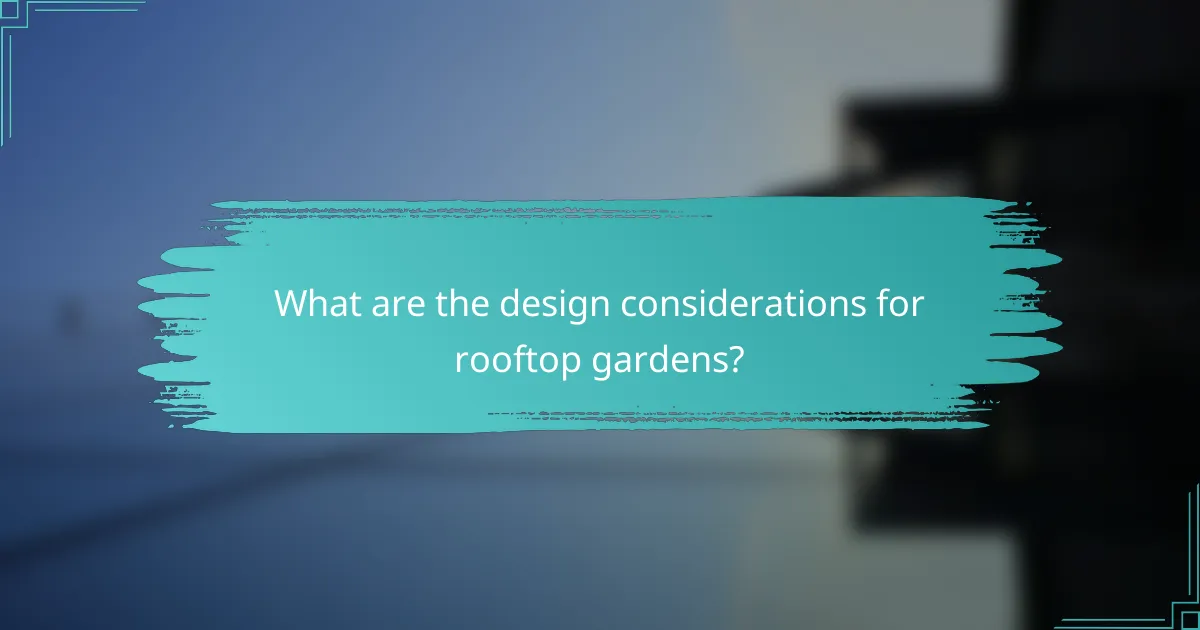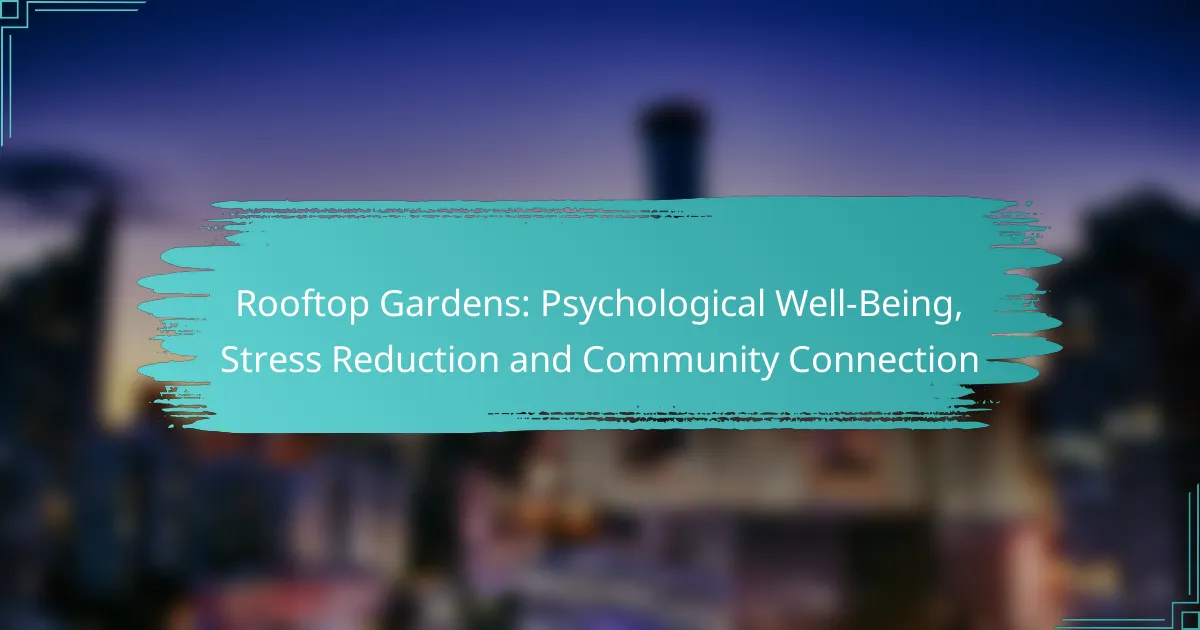Rooftop gardens serve as vital green spaces that significantly enhance psychological well-being by promoting relaxation and reducing stress. These urban oases not only beautify the environment but also foster community connections, allowing individuals to engage in shared activities and build meaningful relationships. By providing a refuge from the hectic pace of city life, rooftop gardens contribute to a healthier, more connected urban experience.

How do rooftop gardens improve psychological well-being?
Rooftop gardens enhance psychological well-being by providing green spaces that promote relaxation, reduce stress, and foster community connections. These gardens create an environment that supports mental health through natural beauty and social interaction.
Enhanced mood and emotional health
Rooftop gardens can significantly enhance mood and emotional health by offering a serene escape from urban environments. The presence of plants and flowers stimulates positive feelings, often leading to increased happiness and satisfaction.
Engaging with nature, even in small doses, has been shown to elevate serotonin levels, which can improve overall emotional well-being. Regular visits to a rooftop garden can create a routine that reinforces positive mental states.
Reduction in anxiety and depression
Access to rooftop gardens can lead to a notable reduction in anxiety and depression symptoms. The calming effects of greenery and the opportunity for quiet reflection help alleviate feelings of stress and tension.
Studies suggest that spending time in nature can lower cortisol levels, the hormone associated with stress. Incorporating time in a rooftop garden into daily life can serve as a natural remedy for those experiencing mild to moderate anxiety or depressive symptoms.
Increased mindfulness and relaxation
Rooftop gardens promote increased mindfulness and relaxation by providing a tranquil setting for individuals to unwind. The act of tending to plants or simply enjoying the view encourages a focus on the present moment, which can enhance mental clarity.
Practicing mindfulness in a rooftop garden can be as simple as observing the growth of plants or listening to the sounds of nature. This practice can lead to improved stress management and a greater sense of peace in one’s daily life.

What are the stress reduction benefits of rooftop gardens?
Rooftop gardens provide significant stress reduction benefits by creating green spaces that promote relaxation and well-being. These gardens not only enhance the aesthetic appeal of urban environments but also serve as a refuge from the hustle and bustle of city life.
Natural stress relief through greenery
Exposure to greenery has been shown to lower stress levels and improve mood. Rooftop gardens offer a unique opportunity for city dwellers to connect with nature, which can lead to a sense of tranquility and peace. Simple activities like gardening or sitting among plants can foster mindfulness and reduce anxiety.
Incorporating elements such as flowers, shrubs, and trees can enhance the calming effect of these spaces. Even small rooftop gardens can provide a significant boost to mental health, making them a valuable addition to urban living.
Impact of nature on cortisol levels
Nature has a profound effect on cortisol, the hormone associated with stress. Studies indicate that spending time in green environments can lower cortisol levels, contributing to overall stress reduction. Rooftop gardens, with their natural elements, can create a soothing atmosphere that helps mitigate the body’s stress response.
Regular visits to these gardens can lead to sustained lower cortisol levels, promoting long-term mental health benefits. Engaging with nature for even short periods can be effective, with just 10-20 minutes of exposure yielding noticeable improvements in stress levels.
Social interaction and support
Rooftop gardens can serve as communal spaces that foster social interaction and support among residents. These gardens provide a platform for community engagement, allowing individuals to connect over shared interests in gardening and nature. Such interactions can enhance feelings of belonging and reduce feelings of isolation.
Organizing community events, such as gardening workshops or social gatherings, can further strengthen these connections. By encouraging collaboration and communication, rooftop gardens can play a crucial role in building supportive networks within urban communities.

How do rooftop gardens foster community connection?
Rooftop gardens create opportunities for community connection by bringing people together through shared activities and experiences. These green spaces serve as communal hubs where individuals can interact, collaborate, and build relationships, enhancing the sense of belonging within a neighborhood.
Shared gardening experiences
Participating in shared gardening activities allows community members to collaborate on planting, maintaining, and harvesting crops. This teamwork fosters camaraderie and encourages communication among participants, leading to stronger social ties. Regular gardening sessions can also provide a structured way for neighbors to meet and engage with one another.
Community members can organize workshops or skill-sharing sessions focused on gardening techniques, which not only enhance knowledge but also create lasting friendships. For example, a local rooftop garden might host a monthly event where participants learn about organic gardening practices together.
Community events and gatherings
Rooftop gardens can serve as venues for various community events, such as potlucks, movie nights, or seasonal celebrations. These gatherings provide a relaxed environment for residents to socialize and enjoy each other’s company while appreciating the beauty of their shared green space. Events can be tailored to the interests of the community, ensuring higher participation rates.
Organizing events like farmers’ markets or plant swaps can further strengthen community bonds. These activities not only promote local produce but also encourage residents to share their gardening successes and challenges, fostering a sense of unity.
Building social networks
Rooftop gardens facilitate the creation of social networks by connecting individuals with similar interests and values. As people engage in gardening and related activities, they naturally form friendships that extend beyond the garden. This network can provide support, resources, and information, enriching the community experience.
To maximize these connections, communities can create online platforms or social media groups where members can share updates, tips, and event information. This digital space complements the physical interactions and helps maintain relationships throughout the year, even when gardening activities may slow down during colder months.

What are the design considerations for rooftop gardens?
Designing rooftop gardens requires careful planning to maximize space, ensure safety, and select appropriate plants. Key considerations include layout, plant choices suited for urban conditions, and accessibility features to create a functional and inviting environment.
Space utilization and layout
Effective space utilization in rooftop gardens involves strategic layout planning to optimize available area. Consider dividing the space into zones for different activities, such as relaxation, gardening, and social gatherings. Utilizing vertical gardening techniques can also help maximize limited space.
Incorporating movable furniture can enhance flexibility, allowing for easy reconfiguration based on seasonal needs or events. Additionally, ensuring pathways are clear and accessible will promote ease of movement throughout the garden.
Plant selection for urban environments
Choosing the right plants for rooftop gardens is crucial, especially in urban settings where conditions can be harsh. Opt for drought-resistant and low-maintenance plants that can thrive in containers, such as succulents, herbs, and native species. These plants are typically more resilient to pollution and temperature fluctuations.
Consider incorporating a mix of perennials and annuals to provide year-round interest and color. Additionally, using plants that attract pollinators can enhance biodiversity and contribute to the local ecosystem.
Accessibility and safety features
Accessibility is a vital consideration for rooftop gardens, ensuring that all individuals can enjoy the space. Incorporate features such as ramps, wide pathways, and seating areas that accommodate various mobility needs. Clear signage can also help navigate the garden effectively.
Safety features should include sturdy railings, non-slip surfaces, and proper drainage to prevent water accumulation. Regular maintenance checks are essential to address any potential hazards, ensuring a safe environment for all users.

What are the costs associated with creating a rooftop garden?
Creating a rooftop garden involves various costs, including initial setup expenses and ongoing maintenance. Understanding these financial aspects is crucial for effective planning and budgeting.
Initial setup costs
Initial setup costs for a rooftop garden can vary significantly based on size, design, and materials used. On average, these costs can range from a few thousand to tens of thousands of dollars. Key expenses include structural assessments, soil, plants, irrigation systems, and gardening tools.
It’s essential to consider hiring professionals for design and installation, which can add to the upfront costs. However, DIY options can help reduce expenses if you have the necessary skills and resources.
Maintenance expenses
Maintenance expenses for rooftop gardens typically include water, fertilizers, pest control, and plant replacement. Monthly costs can range from low tens to a few hundred dollars, depending on the garden’s size and complexity. Regular upkeep is crucial to ensure the garden remains healthy and vibrant.
Additionally, consider seasonal maintenance needs, such as winterizing plants or replacing annuals, which can impact your budget throughout the year.
Potential funding and grants
Various funding opportunities and grants may be available to support the creation and maintenance of rooftop gardens. Local governments, non-profits, and environmental organizations often provide financial assistance for green initiatives. Researching these options can help offset some of the costs associated with your rooftop garden.
Check with local agricultural extension offices or community development programs for specific grants or funding opportunities in your area. Engaging with community groups can also provide valuable resources and support for your project.

What are successful examples of rooftop gardens in urban areas?
Successful rooftop gardens in urban areas enhance the environment, promote community engagement, and improve mental well-being. Notable examples include Brooklyn Grange in New York City, Sky Garden in London, and Chicago’s City Farm, each showcasing unique benefits and approaches to urban greening.
Brooklyn Grange in New York City
Brooklyn Grange is a pioneering rooftop farm that spans over two acres across multiple rooftops in Brooklyn. It focuses on sustainable agriculture by growing organic vegetables and herbs while also hosting educational programs and community events.
This farm not only provides fresh produce but also contributes to local biodiversity and reduces urban heat. Visitors can participate in workshops and volunteer opportunities, fostering a sense of community and connection among city dwellers.
Sky Garden in London
Sky Garden, located atop the “Walkie Talkie” building, offers a unique blend of public space and greenery in the heart of London. This landscaped garden features observation decks, restaurants, and event spaces, making it a popular destination for both locals and tourists.
The design emphasizes accessibility, allowing visitors to enjoy stunning views of the city while surrounded by diverse plant life. Sky Garden promotes mental well-being by providing a tranquil escape from the bustling urban environment.
Chicago’s City Farm
Chicago’s City Farm is an urban agriculture initiative that transforms vacant lots into productive green spaces. This farm grows a variety of fruits and vegetables, which are sold at local farmers’ markets, helping to improve food access in underserved neighborhoods.
City Farm also emphasizes community involvement through educational programs and volunteer opportunities. By engaging residents in gardening and farming practices, it fosters a stronger community connection and promotes sustainable living in the city.
